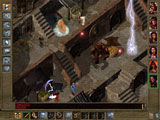 |
|
|
||||||||||
For those of you
unfamiliar with the Baldur’s Gate story, BGII takes up right after the battle with
Saravok in the original. On your way from the
city of Baldur’s Gate, unknown assailants lie in ambush, and you wake to find
yourself the subject of experiments undertaken by an unknown mage. The immediate goal is escape, but you soon find
yourself trying to locate and confront this mage as well as define yourself in relation to
your pedigree as one of the offspring of the god of murder: Baal. BGII features a much darker storyline than the
first game. You have the option of being as
evil as you want (unlike the BGI) and much of BGII’s tension comes from its
psychologically driven narrative.
Also improved over
the original is interaction with Non-Player Characters.
Now NPCs have quests specific to them and interact with each other in
interesting ways. They fight, argue, and will
disagree, sometimes vehemently, with ethical standards of other party members. They recognize your sex and various romance
possibilities have been included. There are
16 NPCs that can join your party – from Keldorn Fircam, an Inquisitor, to Haer’Dalis,
a tiefling Blade – and you will want to play with all of them in order to explore the
side quests they make possible. Each has
extensive scripting which results in well-rounded, believable characters.
Gamplay hasn’t
changed much from BGI. It is still in a ¾
isometric view, but now various pieces of the interface can be hidden and can be run at
800x600 resolution. Additionally, the
configuration utility is excellent, allowing the game to be tweaked with a high degree of
specificity. Under the hood, the infinity
engine has been update to support 3D accelerators for some animations/effects (although I
got better performance by turning acceleration off).
In my opinion, the infinity engine is such a great way to run party-based
adventures (giving the gamer the ability to interact with the terrain and move party
members individually while still providing the performance advantages of primarily 2D
graphics) that the lack of fully 3D environment didn’t bother me.
What I like the
most about BGII is the vast number of variables that increase the replay value. Not only are there a large number of optional
quests with multiple outcomes, but different characters markedly changed my style of play. I’ve put in over 50 hours with several of the
class/kits and each one is a new experience demanding different strategies as well as
different party configurations. This is an
RPG at it’s best in which a good portion of the fun isn’t simply in finishing
the game but in determining what sort of character you will create in getting there. And in a period when the crappiest game costs as
much as the best, BGII delivers so much in proportion to its cost that you come away with
an incredible bargain in terms of the cost to time-spent-playing.  I
have very few criticisms of this game because I’ve been having so much fun. Little, beyond my real life, has jerked me out of
my absorption in the story. I wish there were
greater depth in the type of NPCs that can become part of your party, but, on the whole,
this isn’t so much of a problem as a challenge.
What we’ve got in BGII is a culmination of all the work that went into
Black Isle previous games. There is the
dense, action-packed dungeon crawling of Icewind Dale, the dialogue rich moral development
of Torment, and the well-designed interface of BGI.
I’ll go ahead and predict it gets RPG of the year (even with titles
like Pools of Radiance II and Neverwinter Nights looming on the horizon). To date, I haven’t played anything as
immersive and addicting. BGII sets the
standard for what RPG ought to be.
I hope other production companies take notice. I
have very few criticisms of this game because I’ve been having so much fun. Little, beyond my real life, has jerked me out of
my absorption in the story. I wish there were
greater depth in the type of NPCs that can become part of your party, but, on the whole,
this isn’t so much of a problem as a challenge.
What we’ve got in BGII is a culmination of all the work that went into
Black Isle previous games. There is the
dense, action-packed dungeon crawling of Icewind Dale, the dialogue rich moral development
of Torment, and the well-designed interface of BGI.
I’ll go ahead and predict it gets RPG of the year (even with titles
like Pools of Radiance II and Neverwinter Nights looming on the horizon). To date, I haven’t played anything as
immersive and addicting. BGII sets the
standard for what RPG ought to be.
I hope other production companies take notice.
|